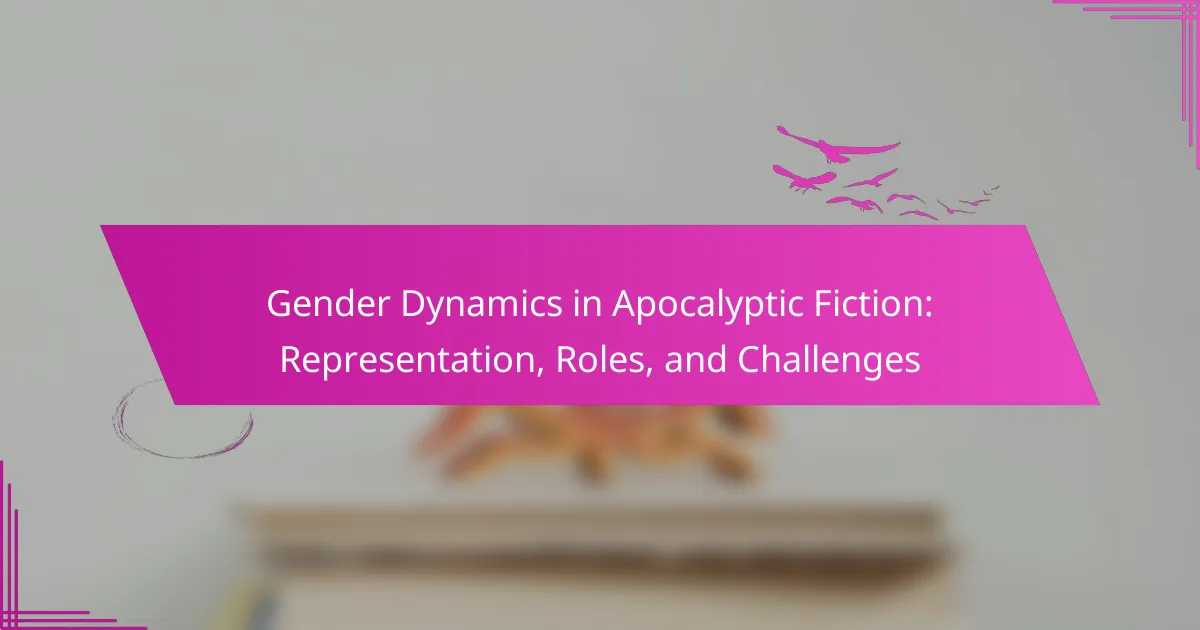Gender dynamics in apocalyptic fiction reveal significant shifts in representation, roles, and societal challenges. These narratives often showcase women in leadership, emphasizing resilience and adaptability. Conversely, traditional male roles are questioned, highlighting vulnerability and emotional depth. Additionally, diverse cultural perspectives and emerging trends in gender representation challenge stereotypes and promote inclusivity.
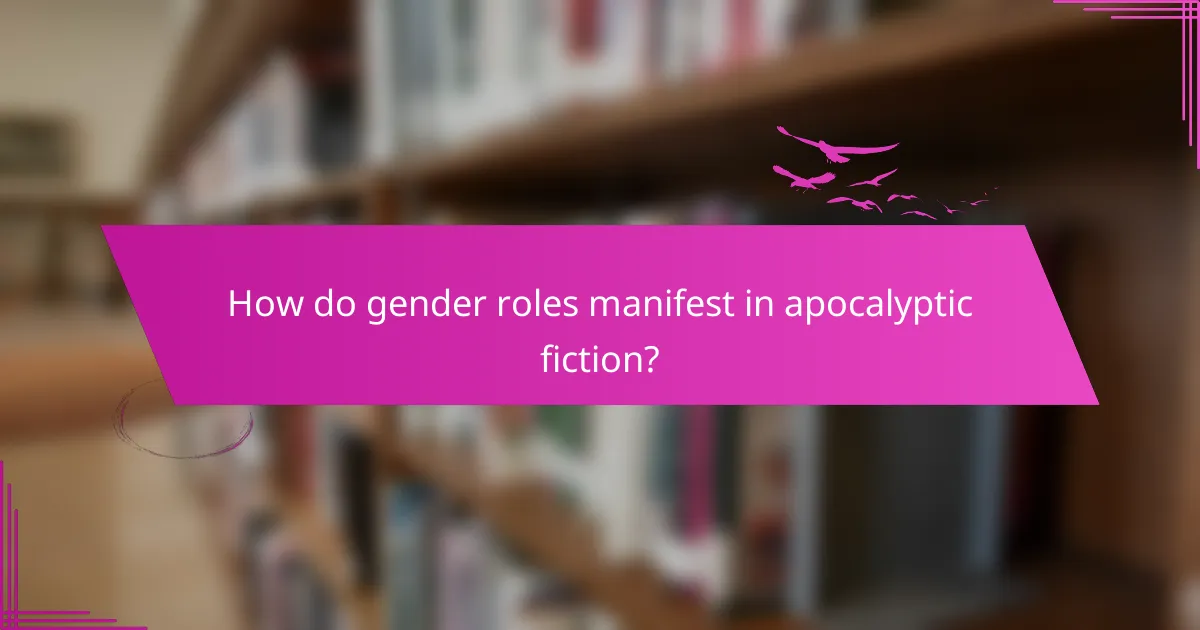
How do gender roles manifest in apocalyptic fiction?
Gender roles in apocalyptic fiction often highlight shifting dynamics, revealing societal expectations and challenges. Women frequently assume leadership roles, showcasing resilience and resourcefulness. Conversely, traditional male roles may be challenged, emphasizing vulnerability and emotional depth. This representation reflects evolving gender norms and critiques of patriarchal structures. For instance, characters such as Furiosa in “Mad Max: Fury Road” exemplify unique attributes of strength and agency, reshaping perceptions of femininity in crisis scenarios. Overall, these narratives explore how survival situations can redefine gender roles and expectations.
What are the traditional representations of gender in dystopian narratives?
Traditional representations of gender in dystopian narratives often depict men as dominant figures and women in subordinate roles. These narratives reflect societal norms, emphasizing power dynamics and gender stereotypes. For instance, male characters frequently assume leadership positions, while female characters are often relegated to caregiving or victim roles.
In many dystopian stories, women are portrayed as either nurturing figures or rebels challenging the status quo. This binary representation highlights the tension between traditional gender roles and emerging feminist themes. Notably, some narratives subvert these conventions, showcasing strong female leads who resist oppression.
Such representations can reveal deeper societal critiques, illustrating how gender dynamics evolve under extreme circumstances. Dystopian fiction often uses these portrayals to explore themes of survival, agency, and identity, reflecting both historical and contemporary gender issues.
How do female characters challenge or conform to stereotypes?
Female characters in apocalyptic fiction often challenge stereotypes by displaying resilience and leadership. They frequently take on roles traditionally associated with male characters, such as warriors or strategists. This shift reflects broader societal changes in gender dynamics.
For instance, characters like Furiosa in “Mad Max: Fury Road” embody strength and resourcefulness, breaking away from passive female roles. In contrast, some narratives still conform to stereotypes, presenting women primarily as caregivers or victims.
This duality highlights a unique attribute of the genre: it can simultaneously reinforce and subvert gender norms. Female characters’ representations can vary significantly, showcasing both rare instances of empowerment and common tropes of vulnerability.
Overall, the portrayal of female characters in apocalyptic fiction serves as a lens to examine evolving gender roles and societal expectations.
Which male archetypes dominate apocalyptic storylines?
Male archetypes that dominate apocalyptic storylines include the hero, the anti-hero, the reluctant leader, and the lone wolf. These archetypes often represent strength, resilience, and complex moral dilemmas.
The hero embodies bravery and selflessness, often rallying others against adversity. The anti-hero presents a morally ambiguous figure, navigating survival with questionable ethics. The reluctant leader grapples with the burden of leadership, showcasing vulnerability and internal conflict. The lone wolf operates independently, emphasizing themes of isolation and self-reliance.
These archetypes reflect societal views on masculinity and survival, challenging traditional gender roles in extreme circumstances. Each character type contributes uniquely to narrative tension and thematic depth in apocalyptic fiction.

What challenges do authors face in depicting gender dynamics?
Authors face numerous challenges in depicting gender dynamics within apocalyptic fiction. These include balancing character representation, avoiding stereotypes, and addressing societal norms.
One significant challenge is the need for authentic representation. Authors must create complex characters that reflect diverse gender identities and experiences, which can be difficult in a genre often focused on survival and conflict.
Additionally, authors confront the risk of reinforcing traditional gender roles. In apocalyptic settings, characters may default to stereotypical behaviors, limiting the scope for nuanced portrayals.
Finally, societal expectations can pressure authors to conform to prevailing narratives about gender, which may stifle creativity and lead to predictable storylines. This tension between innovation and expectation is a recurring theme in the genre.
How does societal context influence character development?
Societal context significantly shapes character development in apocalyptic fiction by influencing gender dynamics. Characters often reflect societal roles, expectations, and challenges related to gender. For instance, women may be portrayed as nurturing survivors, while men might embody strength and leadership. These dynamics can reveal underlying societal issues, such as gender inequality or empowerment. Furthermore, unique attributes, such as leadership styles or emotional resilience, emerge based on these contexts. As a result, character arcs often mirror societal shifts, making them relatable and reflective of real-world gender challenges.
What are the implications of gender representation on audience perception?
Gender representation significantly influences audience perception by shaping narratives and character dynamics. Diverse portrayals foster empathy and relatability, while stereotypes can reinforce biases. In apocalyptic fiction, female characters often challenge traditional roles, promoting a more nuanced understanding of gender. This shift can lead to broader acceptance and appreciation of varied experiences, ultimately enriching audience engagement.
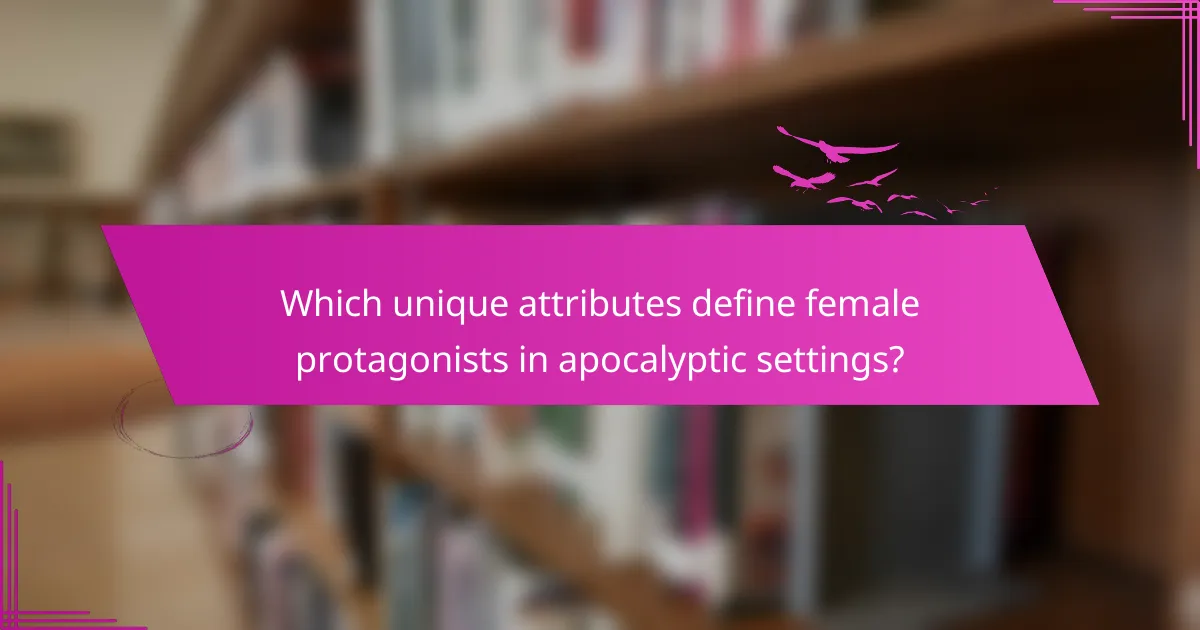
Which unique attributes define female protagonists in apocalyptic settings?
Female protagonists in apocalyptic settings often embody resilience, adaptability, and leadership. These unique attributes differentiate them from traditional portrayals of women in literature. Resilience allows them to face extreme challenges, while adaptability enables them to navigate changing environments. Leadership emerges as they take charge in chaotic situations, often inspiring others. These traits reflect a broader shift in gender dynamics, showcasing women’s strength in adversity.
How do personal histories shape female characters’ roles?
Personal histories significantly influence female characters’ roles in apocalyptic fiction by shaping their motivations and resilience. These narratives often reflect real-world experiences, highlighting themes of survival, agency, and transformation. Characters with diverse backgrounds exhibit unique traits, such as leadership or vulnerability, which enrich their roles. The interplay of personal history and gender dynamics creates complex portrayals, challenging stereotypes and fostering deeper connections with audiences.
What survival strategies are commonly attributed to women in these narratives?
Women in apocalyptic narratives often employ resilience, resourcefulness, and community-building as survival strategies. These traits highlight their adaptability and strength in dire circumstances.
1. Resilience: Women frequently face emotional and physical challenges, demonstrating the ability to recover and persevere.
2. Resourcefulness: They utilize available resources creatively, often transforming mundane items into survival tools.
3. Community-building: Women often foster collaboration, creating networks that enhance group survival and support.
4. Nurturing roles: Many narratives depict women as caregivers, emphasizing their role in maintaining morale and emotional well-being.
5. Strategic thinking: Women often engage in planning and strategizing, showcasing their ability to think critically under pressure.
6. Leadership: Some narratives feature women in leadership roles, challenging traditional gender dynamics and showcasing their capability to guide others.
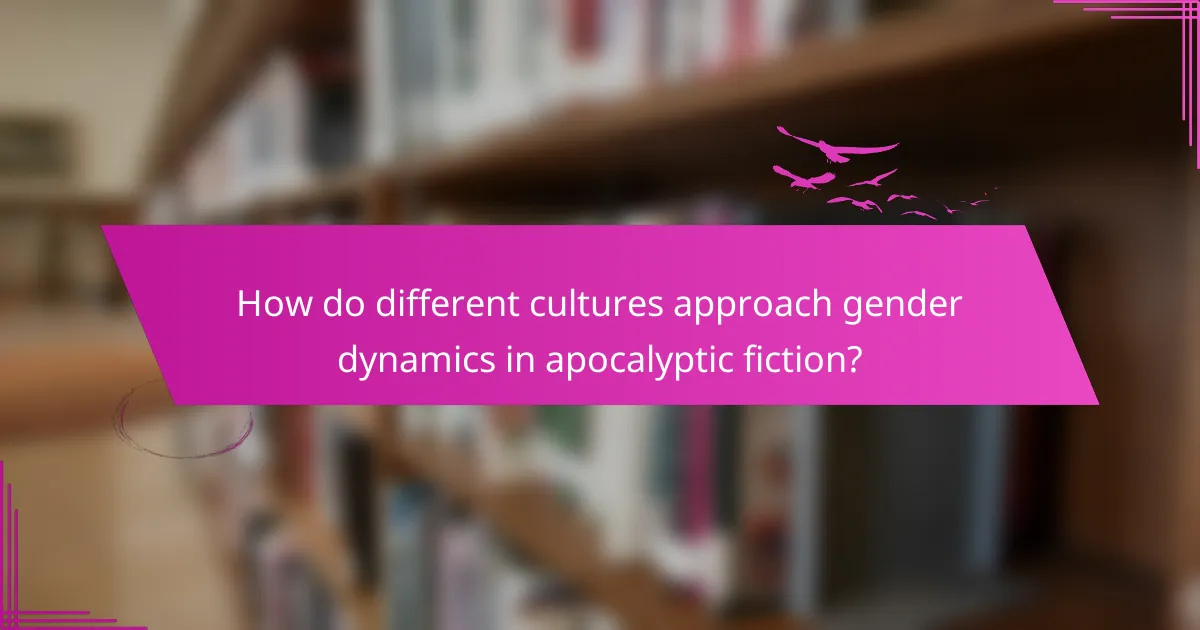
How do different cultures approach gender dynamics in apocalyptic fiction?
Different cultures depict gender dynamics in apocalyptic fiction through varied lenses, reflecting societal values and norms. In Western narratives, women often assume leadership roles, showcasing resilience and adaptability. Conversely, some Eastern stories may present traditional gender roles, emphasizing familial duty and community support.
For instance, Japanese apocalyptic fiction frequently explores themes of sacrifice and collective survival, with gender roles deeply rooted in cultural expectations. In contrast, Scandinavian narratives might highlight egalitarianism, portraying both genders as equally capable in survival scenarios.
Additionally, African apocalyptic tales often incorporate spiritual elements, where gender dynamics intersect with cultural traditions and communal responsibilities. These diverse portrayals challenge stereotypes and invite readers to reconsider their perspectives on gender roles in crisis situations. Overall, cultural context significantly shapes the representation of gender dynamics in apocalyptic fiction.
What are the regional variations in character portrayals?
Regional variations in character portrayals in apocalyptic fiction reflect cultural attitudes towards gender. In North America, female characters often embody resilience, taking on leadership roles. Conversely, in some Asian narratives, traditional gender roles may prevail, depicting women primarily as caregivers. In European works, characters frequently challenge gender norms, showcasing diverse identities. These portrayals vary significantly based on societal context, highlighting unique attributes of gender dynamics in different cultures.
How do cultural expectations influence narrative outcomes?
Cultural expectations significantly shape narrative outcomes in apocalyptic fiction by influencing character roles and relationships. These dynamics often reflect societal views on gender, where traditional roles can be challenged or reinforced. For example, female characters may either embody nurturing qualities or take on leadership roles, altering the story’s direction. As a result, narratives can either reinforce stereotypes or promote progressive representations, impacting audience perceptions of gender roles.
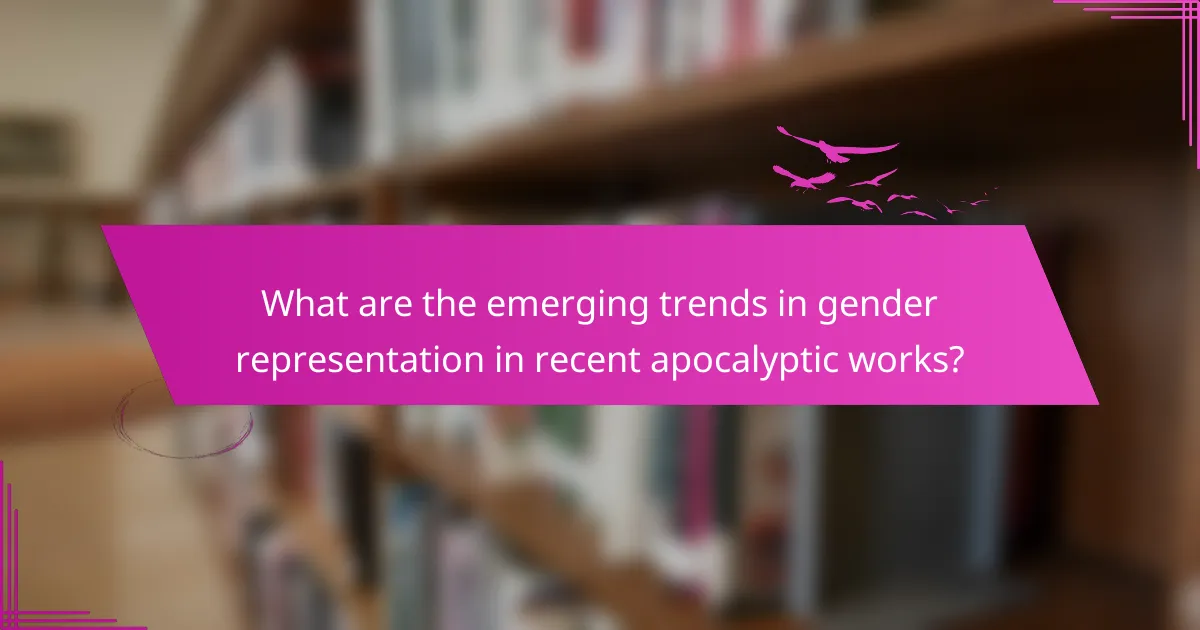
What are the emerging trends in gender representation in recent apocalyptic works?
Emerging trends in gender representation in apocalyptic works show a shift towards more complex and diverse portrayals. Female characters increasingly occupy leadership roles, challenging traditional stereotypes. Many narratives emphasize collaboration over competition, highlighting community-building among genders. Additionally, non-binary and LGBTQ+ characters gain visibility, reflecting broader societal changes. This evolution signifies a move away from binary gender roles, presenting a richer tapestry of human experience in crisis scenarios.
How are intersectional identities being explored in contemporary fiction?
Contemporary fiction explores intersectional identities by highlighting diverse gender dynamics in apocalyptic settings. These narratives often challenge traditional gender roles, showcasing women’s resilience and leadership.
Authors increasingly depict characters with multifaceted identities, reflecting the complexities of race, sexuality, and socio-economic status. This approach enriches storytelling and fosters empathy among readers.
For instance, works like “The Power” by Naomi Alderman illustrate how societal collapse can redefine gender hierarchies, offering a unique lens on power dynamics. Such explorations reveal the challenges faced by marginalized groups in survival scenarios.
As a result, contemporary fiction not only entertains but also provokes critical discussions about identity and representation in extreme circumstances.
What role does technology play in reshaping gender dynamics?
Technology significantly influences gender dynamics in apocalyptic fiction by challenging traditional roles and promoting diverse representations. It enables female characters to assume leadership positions, showcasing their resilience and adaptability. For instance, advancements in digital storytelling allow for complex narratives that highlight women’s experiences in survival scenarios. This shift reflects a broader cultural change towards equality and empowerment. Additionally, technology fosters community building among characters, emphasizing collaboration over competition, which can redefine gender roles in these narratives.
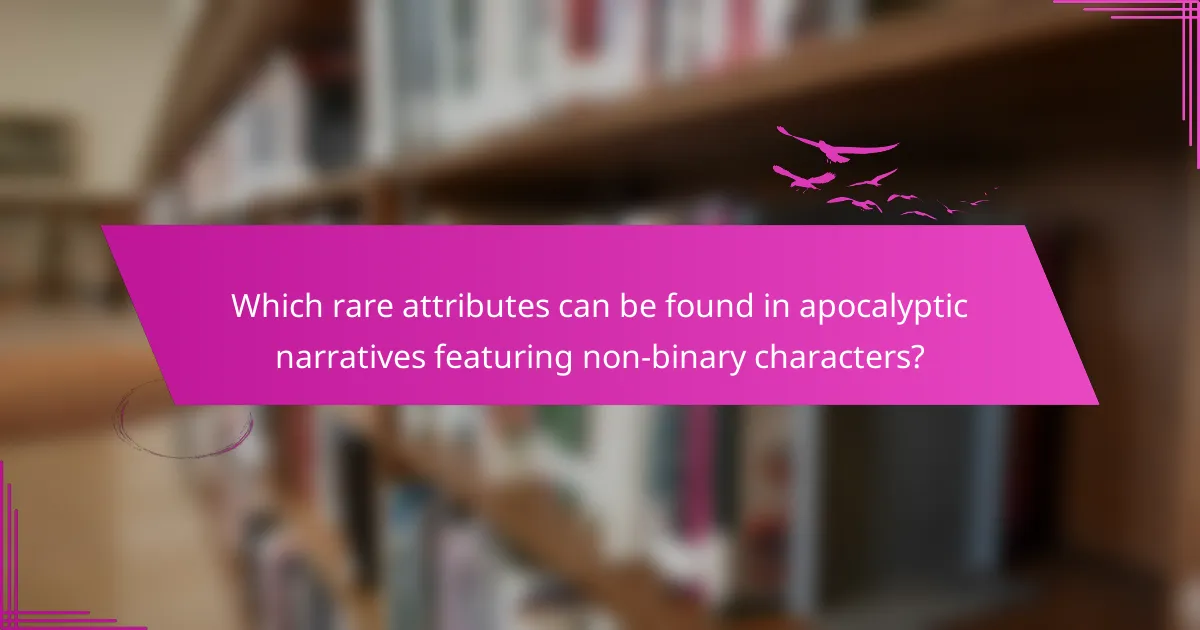
Which rare attributes can be found in apocalyptic narratives featuring non-binary characters?
Apocalyptic narratives featuring non-binary characters often showcase rare attributes such as fluid identity representation, unique survival strategies, and unconventional social structures. These narratives challenge traditional gender roles and explore themes of inclusivity and resilience. Such stories may depict non-binary characters as leaders or visionaries, emphasizing their distinct perspectives in crisis scenarios. Additionally, they may highlight the intersectionality of identity, showcasing how non-binary individuals navigate multiple societal challenges in post-apocalyptic settings.
How do non-binary identities challenge traditional gender roles?
Non-binary identities challenge traditional gender roles by introducing fluidity and complexity into gender dynamics. They disrupt binary classifications, encouraging broader representation in apocalyptic fiction. Non-binary characters often embody unique attributes that reflect diverse experiences, fostering inclusivity. This representation can challenge stereotypes, prompting audiences to rethink conventional gender norms in crisis scenarios. As a result, narratives can explore themes of identity, resilience, and community beyond traditional gender confines.
What unique perspectives do non-binary characters bring to survival scenarios?
Non-binary characters bring diverse perspectives to survival scenarios by challenging traditional gender roles. Their unique experiences can foster collaboration and empathy among group members. This representation encourages narratives that explore identity and community in crisis, enhancing emotional depth and complexity. Non-binary characters often embody resilience, illustrating that survival strategies are not bound by conventional gender expectations. This inclusion promotes a broader understanding of humanity in extreme situations, enriching the apocalyptic fiction genre.
How can authors authentically represent non-binary experiences?
Authors can authentically represent non-binary experiences by focusing on character depth and diverse narratives. They should avoid stereotypes and instead highlight individual stories that reflect the complexities of non-binary identities. Engaging with non-binary individuals during the writing process can provide valuable insights. Additionally, integrating non-binary perspectives into the broader context of gender dynamics in apocalyptic fiction can enhance authenticity and relatability. This approach fosters a richer exploration of identity amidst societal collapse.
What best practices should writers follow for inclusive representation?
Writers should prioritize diverse character representation, avoid stereotypes, and incorporate authentic voices. They must create complex, multidimensional characters that reflect varied experiences in gender dynamics. This ensures a more relatable and inclusive narrative. Additionally, engaging with feedback from underrepresented groups can enhance authenticity and depth in storytelling.
